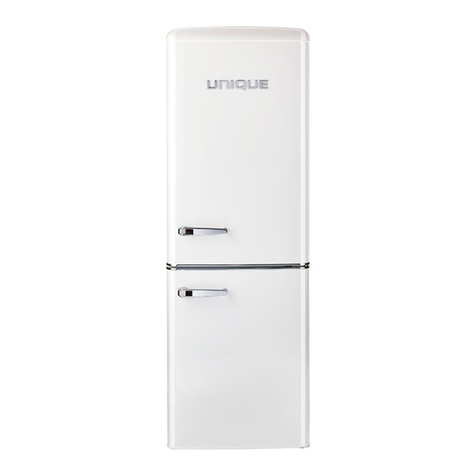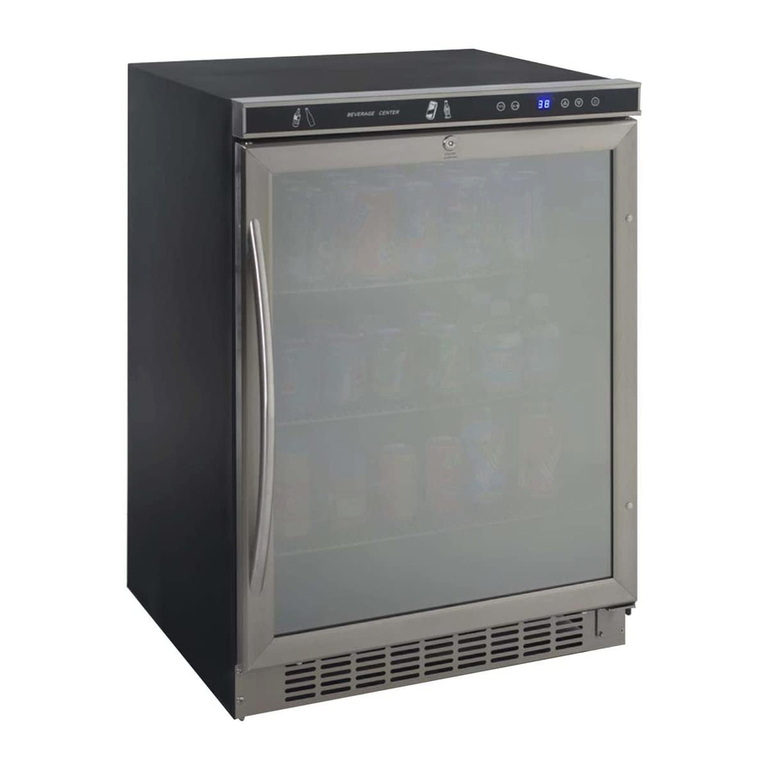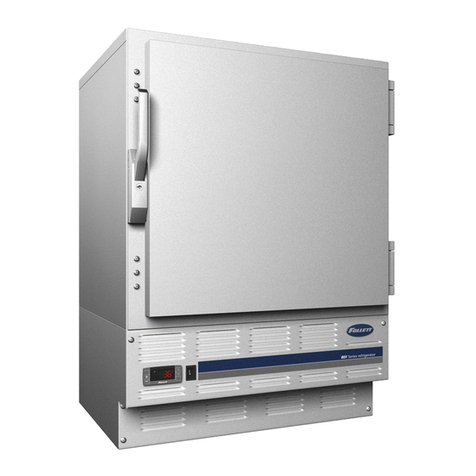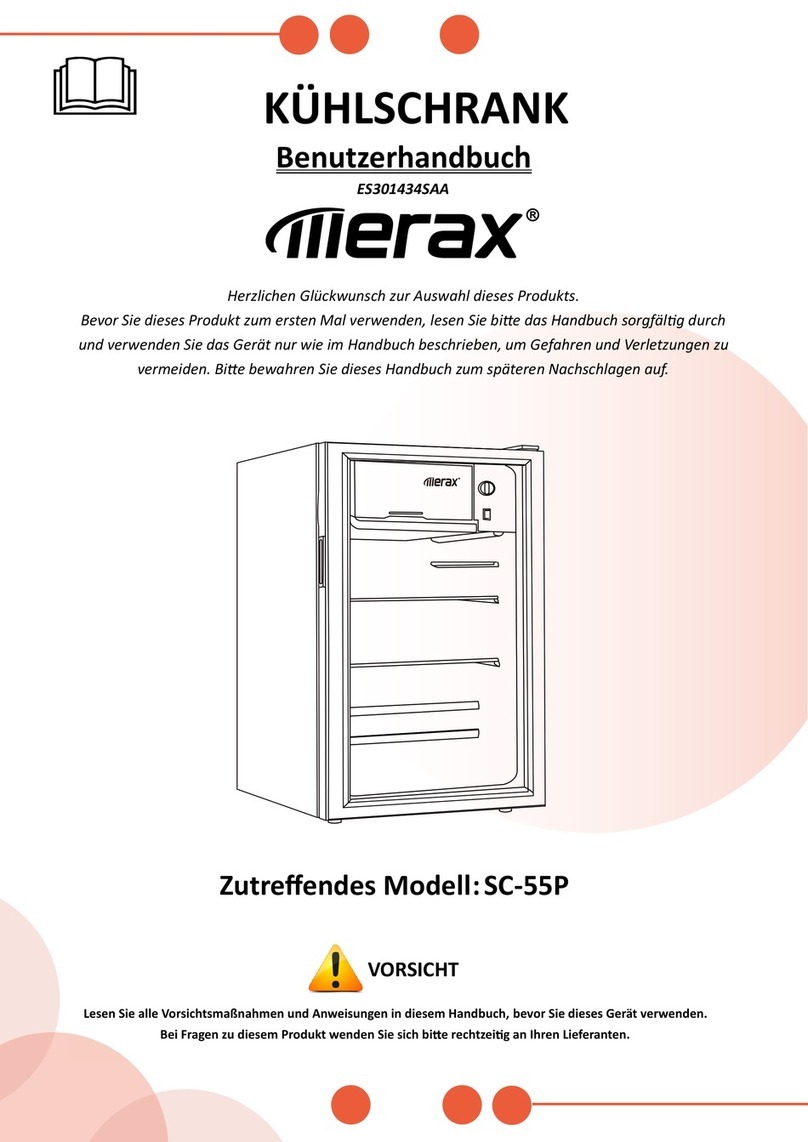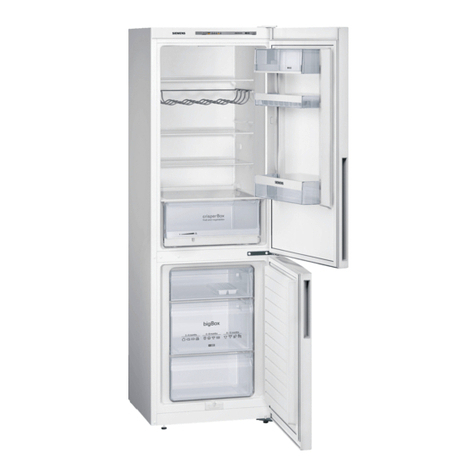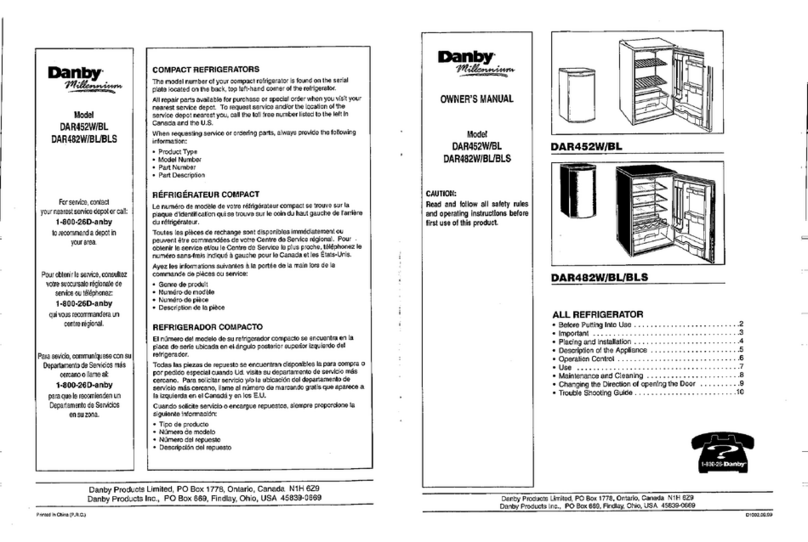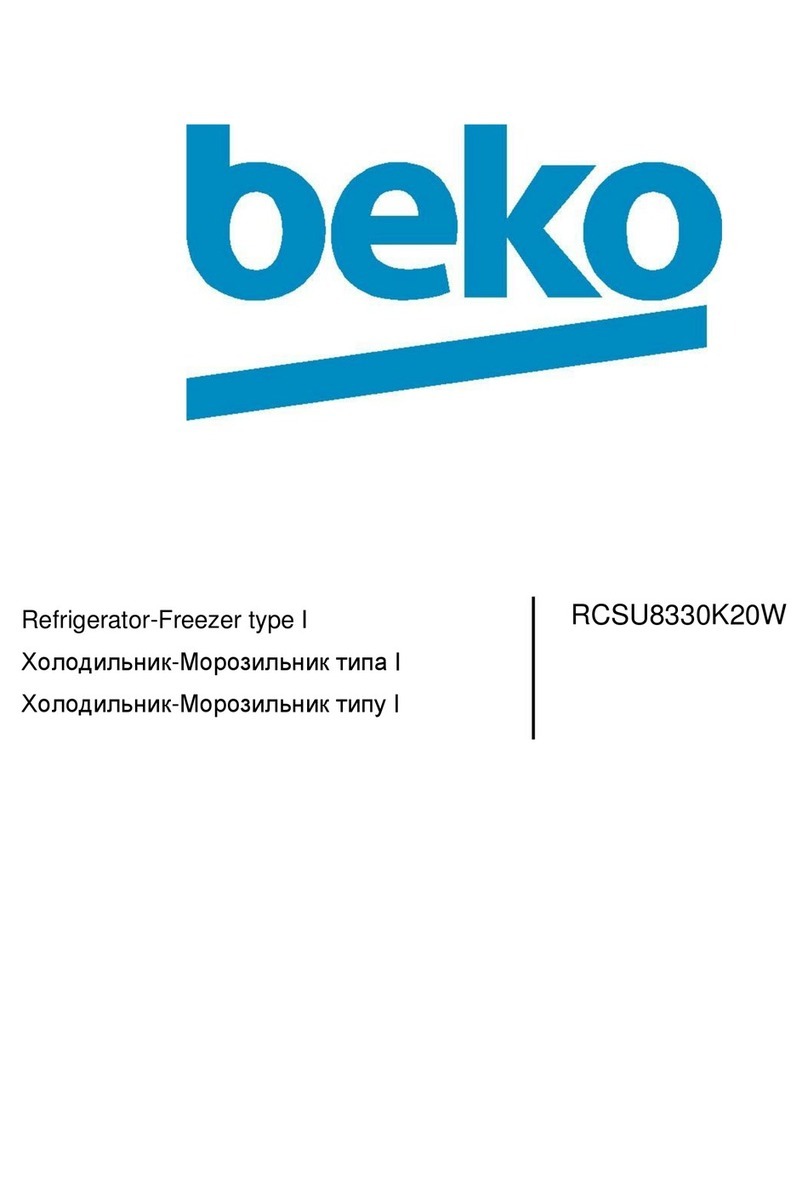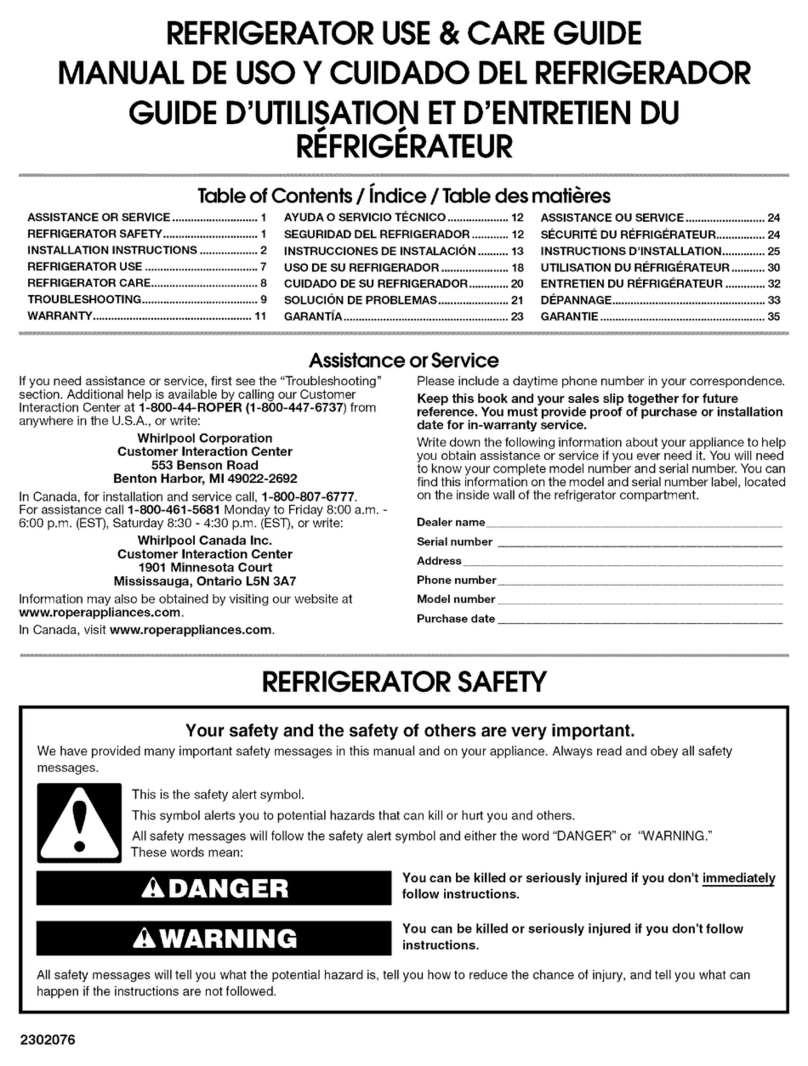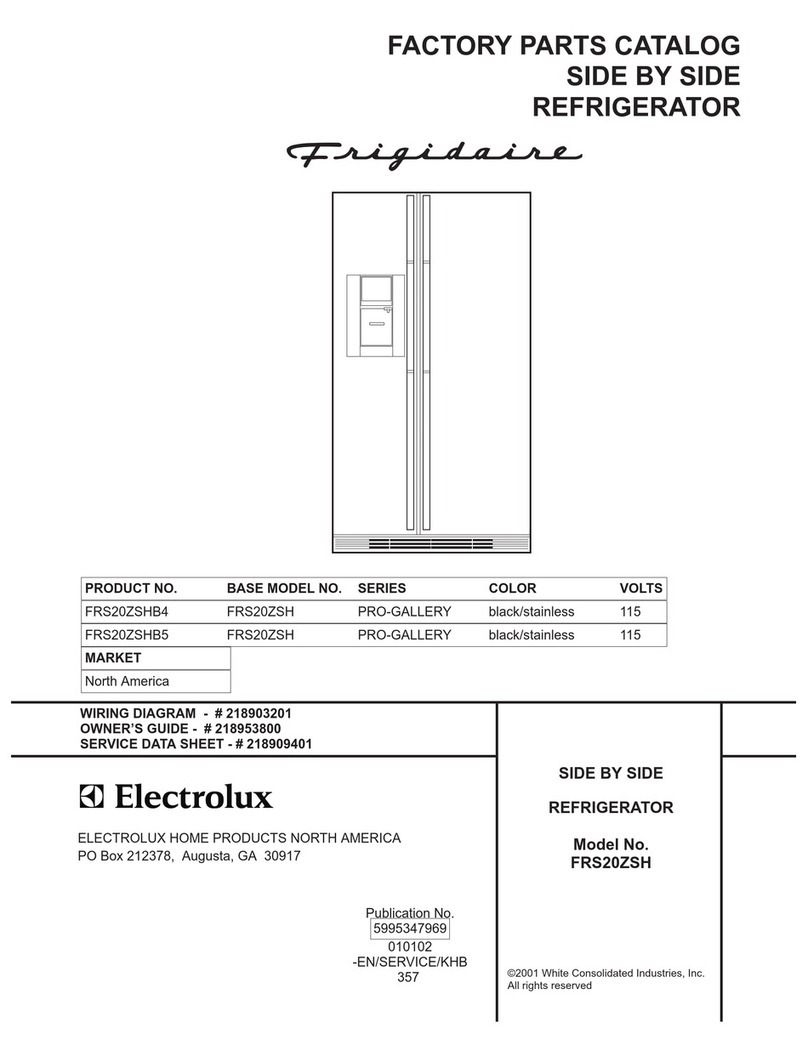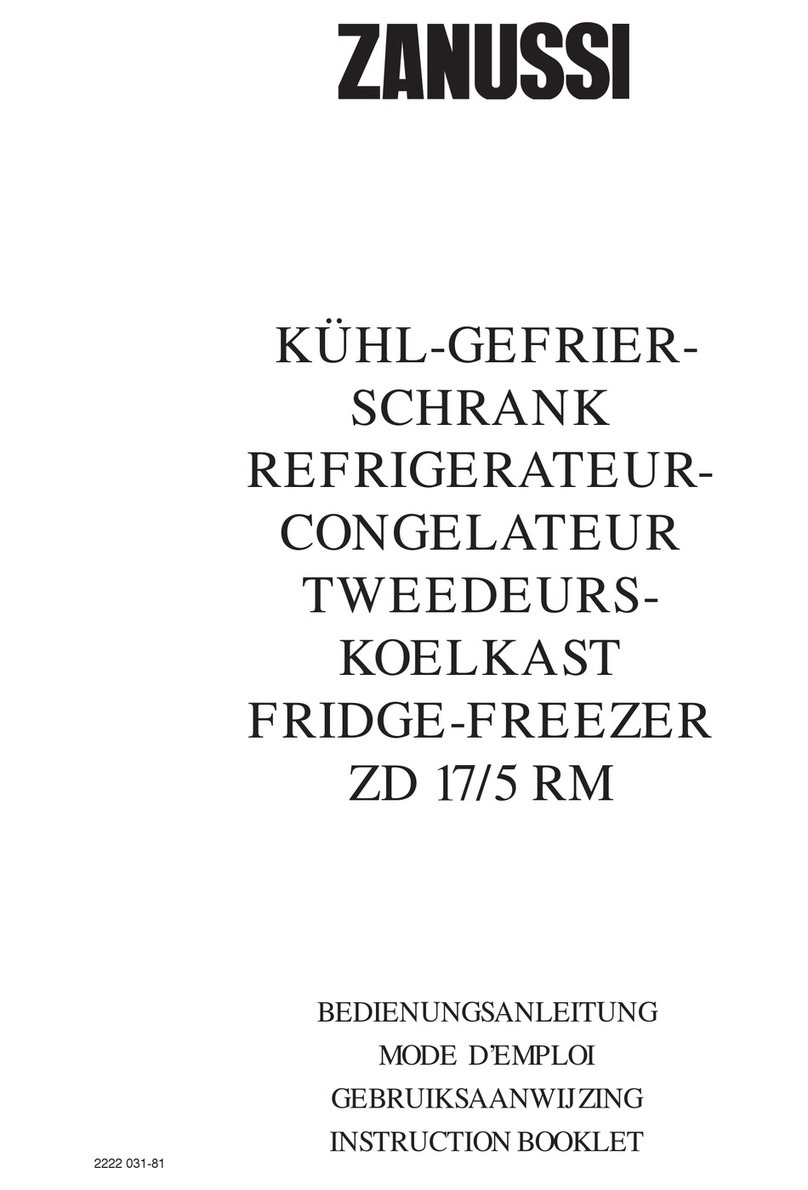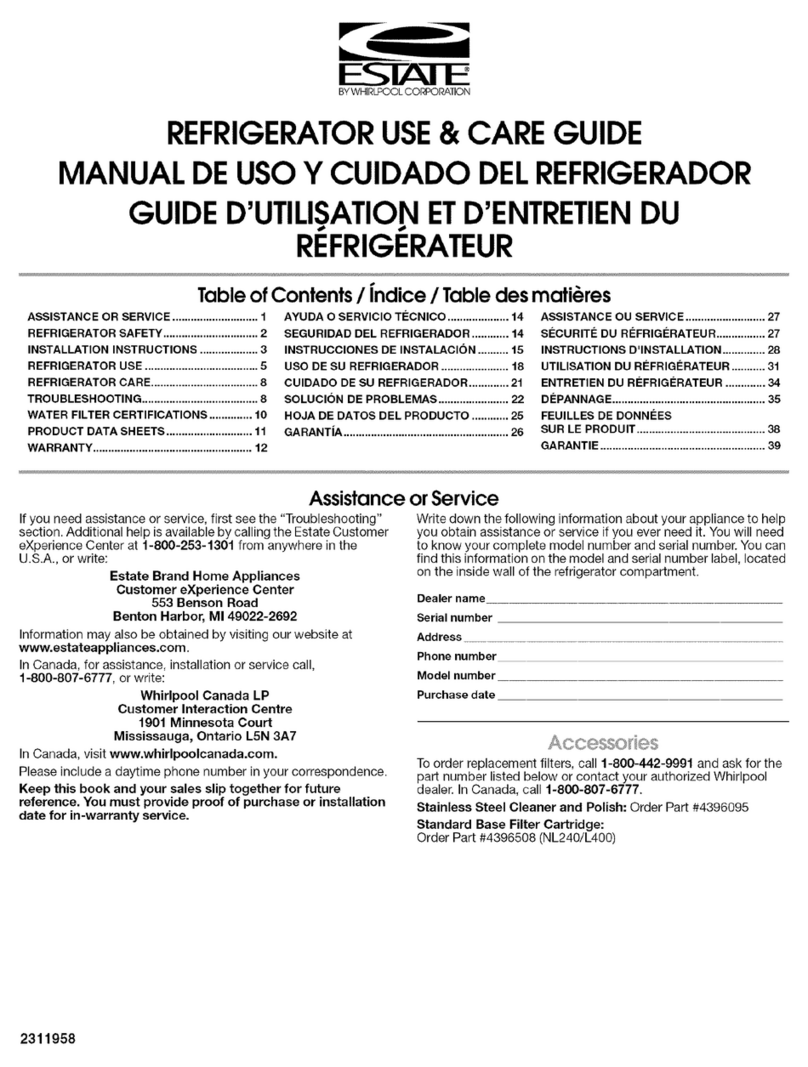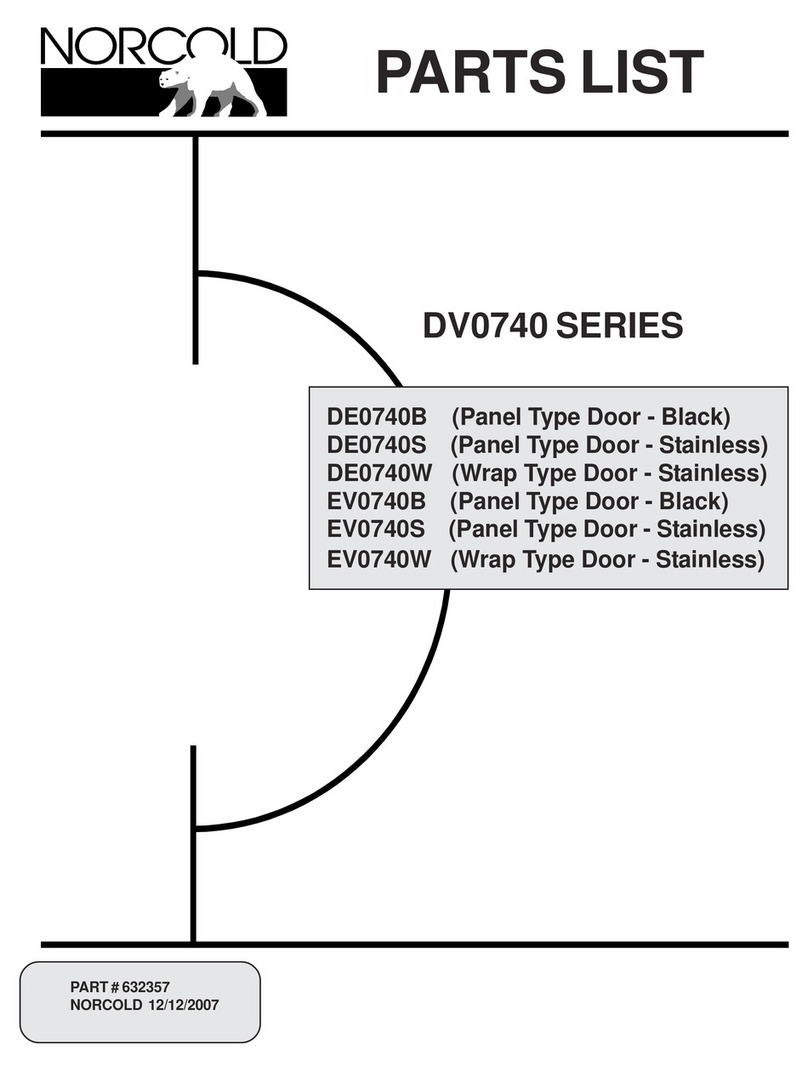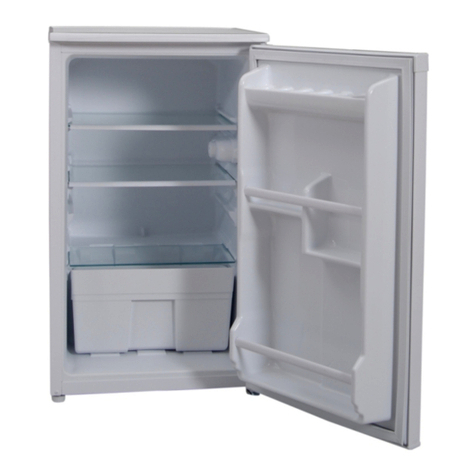Malloca MF-241BCD User manual

Please read the Manual carefully before use.
The Manual shall be kept in good custody for
later reference
User Manual
Model: MF-241BCD

CONTENTS
1 Safety warnings
2.1 Placement· · · · · · · · · · · · · · · · · · · · · · · · · · · · · · · · · · · 5
2.2 Installation in cabinet···································6-7
2.3 Door Right-Left Change································8-10
2.4 Changing the Light···································11
2.5 Starting to use·····································11
2.6 Energy saving tips···· ····· ····· ··········· ····· ·····11
4.1 Overall cleaning· · · · · · · · · · · · · · · · · · · · · · · · · · · · · · · · 14
4.2 Defrosting· · · · · · · · · · · · · · · · · · · · · · · · · · · · · · · · · · · 14
4.3 Out of operation· · · · · · · · · · · · · · · · · · · · · · · · · · · · · · · · · 14
6.1 Technical parameters· · · · · · · · · · · · · · · · · · · · · · · · · · · · · ·16-17
1.1 Warning····· ····· ····· ····· ····················1
1.2 Meanings of safety warning symbols· · · · · · · · · · · · · · · · · · · · · · · · · · 2
1.3 Electricity related warnings· · · · · · · · · · · · · · · · · · · · · · · · · · · · · · 2
1.4 Warnings for using· · · · · · · · · · · · · · · · · · · · · · · · · · · · · · · 3
1.5 Warnings for placement · · · · · · · · · · · · · · · · · · · · · · · · · · · · · 3-4
1.6 Warnings for energy· · · · · · · · · · · · · · · · · · · · · · · · · · · · · · 4
1.7 Warnings for disposal· · · · · · · · · · · · · · · · · · · · · · · · · · · · · · 4
2 Proper use of the refrigerator
3 Structure and functions
3.1 Key components· · · · · · · · · · · · · · · · · · · · · · · · · · · · · 12
3.2 Functions· · · · · · · · · · · · · · · · · · · · · · · · · · · · · · · · · · · 13
4 Maintenance and care of the refrigerator
5.1 Trouble shooting· · · · · · · · · · · · · · · · · · · · · · · · · · · · · · · · · 15
6 Parameters
5 Trouble shooting

1
1
1 Safety warnings
1.1 Warning
RECOMMENDATIONS:
This appliance is intended to be used in household and similar applications such as
staff kitchen areas in shops, offices and other working environments;
farm houses and by clients in hotels, motels and other residential type environments;
bed and breakfast type environments;
catering and similar non-retail applications.
(Europe directive optional)
For EN standard: This appliance can be used by children aged from 8 years and above and persons with reduce
physical sensory or mental capabilities or lack of experience and knowledge if they have been given supervision
or instruction concerning use of the appliance in a safe way and understand the hazards involved. Children shall
not play with the appliance. Cleaning and user maintenance shall not be made by children without supervision.
(Europe directive optional)
For IEC standard: This appliance is not intended for use by persons (including children) with reduced physical,
sensory or mental capabilities, or lack of experience and knowledge, unless they have been given supervision or
instruction concerning use of the appliance by a person responsible for their safety.)
Children should be supervised to ensure that they do not play with the appliance.
If the supply cord is damaged, it must be replaced by the manufacturer, its service agent or similarly qualified
persons in order to avoid a hazard.
Do not store explosive substances such as aerosol cans with a flammable propellant in this appliance.
The appliance has to be unplugged after use and before carrying out user maintenance on the appliance.
WARNING: Risk of fire / flammable materials.
WARNING: Keep ventilation openings, in the appliance enclosure or in the built-in structure, clear of obstruction.
WARNING: Do not use mechanical devices or other means to accelerate the defrosting process, other than those
recommended by the manufacturer.
WARNING: Do not damage the refrigerant circuit.
WARNING: Do not use electrical appliances inside the food storage compartments of the appliance,
unless they are of the type recommended by the manufacturer.
WARNING: Please abandon the refrigerator according to local regulators for it use flammable blowing gas
and refrigerant.
Do not use extension cords or ungrounded(two prong)adapters
DANGER:Risk of child entrapment.Before you throw away your old refrigerator or freezer:
-Take off the doors
-Leave the shelves in place so that children may not easily climb inside
The refrigerator must be disconnected from the source of electrical supply before attempting the installation
of accessory
Refrigerant and cyclopentane foaming material used for the refrigerator are flammable.
Therefore, when the refrigerator is scraped, it shall be kept away from any fire source and
be recovered by a special recovering company with corresponding qualification other than
be disposed by combustion, so as to prevent damage to the environment or any other harm.
Warning:risk of fire / flammable materials
1

This manual contains lots of important safety information
which shall be observed by the users.
1.2 Meaning of safety warning symbols
Prohibition symbol
Warning symbol
Note symbol
This is a prohibition symbol.
Any incompliance with instructions marked with
this symbol may result in damage to the product
or endanger the personal safety of the user.
This is a warning symbol.
It is required to operate in strict observance of
instructions marked with this symbol; or otherwise
damage to the product or personal injury may be caused.
This is a cautioning symbol.
Instructions marked with this symbol require special caution.
Insufficient caution may result in slight or moderate injury,
or damage to the product.
2
1.3 Electricity related warnings
Do not pull the power cord when pulling the power plug of the
refrigerator. Please firmly grasp the plug and pull out it from
the socket directly.
To ensure safe use, do not damage the power cord or use the power cord
when it is damaged or worn.
Please use a dedicated power socket and the power socket shall
not be shared with other electrical appliances.
The power plug should be firmly contacted with the socket or else
fires might be caused.
Please ensure that the grounding electrode of the power socket is
equipped with a reliable grounding line.
Do not use electrical appliances on the top of the appliance,
unless they are of the type recommended by the manufacturer.

3
1.5 Warnings for placement
1.4 Warnings for using
Do not put flammable, explosive, volatile and highly corrosive items
in the refrigerator to prevent damages to the product or fire accidents.
Do not place flammable items near the refrigerator to avoid fires.
The refrigerator is intended for household use, such as storage of foods;
it shall not be used for other purposes, such as storage of blood,
drugs or biological products, etc.
Do not arbitrarily disassemble or reconstruct the refrigerator,
nor damage the refrigerant circuit; maintenance of the appliance
must be conducted by a specialist
Damaged power cord must be replaced by the manufacturer, its
maintenance department or related professionals in order to avoid
danger.
Do not allow any child to get into or climb the refrigerator; otherwise
suffocation or falling injury of the child may be caused.
Do not place heavy objects on the top of the refrigerator considering
that objectives may fall when close or open the door, and accidental
injuries might be caused.
Please pull out the plug in case of power failure or cleaning. Do not
connect the freezer to power supply within five minutes to prevent
damages to the compressor due to successive starts.
The gaps between refrigerator doors and between doors and refrigerator
body are small, be noted not to put your hand in these areas to prevent from
squeezing the finger. Please be gentle when close the refrigerator door to
avoid falling articles.
Do not pick foods or containers with wet hands in the freezing chamber when the
refrigerator is running, especially metal containers in order to avoid frostbite.

4
Do not store beer, beverage or other fluid contained in bottles or
enclosed containers in the freezing chamber of the refrigerator;
otherwise the bottles or enclosed containers may crack due to
freezing to cause damages.
1.6 Warnings for energy
Refrigerating appliances might not operate consistently (possibility of defrosting of contents or1)
temperature becoming too warm in the frozen food compartment) when sited for an extended period of
time below the cold end of the range of temperatures for which the refrigerating appliance is designed.
2)The fact that effervescent drinks should not be stored in food freezer compartments or cabinets or
in low-temperature compartments or cabinets, and that some products such as water ices should not be
consumed too cold;
The need to not exceed the storage time(s) recommended by the food manufacturers for any kind of3)
food and particularly for commercially quick-frozen food in food-freezer and frozen-food storage
compartments or cabinets;
The precautions necessary to prevent an undue rise in the temperature of the frozen food while 4)
defrosting the refrigerating appliance, such as wrapping the frozen food in several layers of newspaper.
The fact that a rise in temperature of the frozen food during manual defrosting, maintenance or 5)
cleaning could shorten the storage life.
6)The necessity that, for doors or lids fitted with locks and keys, the keys be kept out of the reach
of children and not in the vicinity of the refrigerating appliance, in order to prevent children from being
locked inside
When the refrigerator is scraped, disassemble the doors, and remove gasket of door and
shelves; put the doors and shelves in a proper place, so as to prevent trapping of any child.
Refrigerant and cyclopentane foaming material used for the refrigerator are flammable.
Therefore, when the refrigerator is scraped, it shall be kept away from any fire source and
be recovered by a special recovering company with corresponding qualification other than
be disposed by combustion, so as to prevent damage to the environment or any other harm.
1.7 Warnings for disposal
Correct Disposal of this product:
This marking indicates that this product should not be disposed with other household
wastes throughout the EU. To prevent possible harm to the environment or human health
from uncontrolled waste disposal, recycle it responsibly to promote the sustainable reuse
of material resources. To return your used device, please use the return and collection
systems or contact the retailer where the product was purchased. They can take this
product for environmental safe recycling.
Freezing chamber

2.1 Placement
2 Proper use of refrigerators
Precautions before installation:
Information in the Instruction Manual is only for reference. The physical product may differ.
Before installation and adjusting of accessories, it shall be ensured that the refrigerator is
disconnected from power.
5
Before use, remove all packing materials, including bottom cushions,
foam pads and tapes inside of the refrigerator;
tear off the protective film on the doors and the refrigerator body.
Keep away from heat and avoid direct sunlight. Do not
place the freezer in moist or watery places to prevent rust
or reduction of insulating effect.
The refrigerator is placed in a well-ventilated indoor place;
the ground shall be flat, and sturdy.
Outer cabinet dimensions, please refer to shown as the left picture
Do not spray or wash the refrigerator; do not put the refrigerator in
moist places easy to be splashed with water so as not to affect the
electrical insulation properties of the refrigerator.
Min.50 mm
Min.550
560
+10
0
1776
0
+10
Min.

2.2 Installation in cabinet
Cabinet size requirement.
Push the refrigerator into the cabinet and adjust it to make sure the edgefold of top baffle completely
touch the top edge of the cabinet, and the limit hook of supporting leg completely touch the bottom edge
of the cabinet.
Fix the supporting leg with screws, then install the screw caps.
Min.50 mm
Min.550
560
+10
0
1776
0
+10
Min.
6
Edgefold of top baffle
Limit hook
Screw cap
Screw

Fix the top baffle to the top of the cabinet inner with screws, then install the screw caps.
Open the lower door of cabinet the maximum angle, and open the lower door of the refrigerator to the
corresponding position. Sliding the block to make sure inner edge align with the lower door edge of
refrigerator, then fix the block to the door of cabinet with screw and install screw caps. Fix the upper
refrigerator door to the cabinet door in the same way.
Take out the sealing strip from accessory bag, and press it in the gap between the cabinet and the
refrigerator. Installation is completed.
7
Screw
Screw cap
Block
Sealing strip
(The picture above is only for reference. The actual configuration will
depend on the physical product or statement by the distributor)

2.3 Door Right-Left Change
Cross screwdriver
List of tools to be provided by the user
5/16″
socket and ratchet Masking tape
Putty knife
thin-blade screwdriver
1)Power off the refrigerator, and remove all objects from the door trays.
3)Remove the refrigerator door, the bottom hinge and the hole cover.
2
)
Remove the upper hinge and hole caps of refrigerator door.
hole caps
upper hinge
hole cover
R:bottom hinge
8

5)Remove the the upper hinge of freezer door.
3)Exchange the R:bottom hinge and R:upper hinge ,then install them according to below steps,
and install the top hole caps.
4) of refrigerator door and rotate them for 180°,Remove the two fixed blocks
and install them on other side of refrigerator door.
F:upper hinge
6)Remove the freezer door, the bottom hinge and the hole caps.
F:bottom hinge
hole caps
9
R:bottom hinge
hole caps
fixed block
R:upper hinge
180°
Step 1:
install l eft botto m hinge
Step2:
put refri gerator
door on lef t bottom
hinge ver tically
Step 3:
install l eft upper h inge

F:upper hinge
F:bottom hinge
9). The picture after completion is shown as below
hole cover
180°
fixed block
7)Exchange the F:bottom hinge and F:upper hinge ,then install them according to below steps,
and install the top hole cover and lower hole caps.
8)Remove the two fixed blocks of freezer door and rotate them for 180°,
and install them on other side of freezer door.
(The picture above is only for reference. The actual configuration will depend on
the physical product or statement by the distributor)
10
hole caps
Step 1:
install l eft botto m hinge
Step2:
put refri gerator
door on lef t bottom
hinge ver tically
Step 3:
install l eft upper h inge

2.4 Starting
2.5 Energy saving tips
The appliance should be located in the coolest area of the room, away from heat
producing appliances or heating ducts, and out of the direct sunlight.
Let hot foods cool to room temperature before placing in the appliance. Overloading
the appliance forces the compressor to run longer. Foods that freeze too slowly may
lose quality, or spoil.
Be sure to wrap foods properly, and wipe containers dry before placing them in the
appliance. This cuts down on frost build-up inside the appliance.
Appliance storage bin should not be lined with aluminum foil, wax paper, or paper
toweling. Liners interfere with cold air circulation, making the appliance less efficient.
Organize and label food to reduce door openings and extended searches. Remove as many
items as needed at one time, and close the door as soon as possible.
Before initial start, keep the refrigerator still for half an hour
before connecting it to power supply.
Before putting any fresh or frozen foods, the refrigerator shall have run
for 2-3 hours, or for above 4 hours in summer when the ambient
temperature is high.
Spare enough space for convenient opening of the doors and drawers or
statement by the distributor.
2.3 Changing the Light
Any replacement or maintenance of the LED lamps is intended to be made by
the manufacturer, its service agent or similar qualified person.
11
480mm
540mm
90°
1060mm

3.1 Key components
(The picture above is only for reference. The actual configuration will depend on
the physical product or statement by the distributor)
3 Structure and functions
Note: Storage of too much food during operation after the initial connection to power may adversely
affect the freezing effect of the refrigerator. Foods stored shall not block the air outlet; or otherwise
the freezing effect will also be adversely affected.
Freezing chamber
The low temperature freezing chamber may keep food fresh for a long time and it is mainly used to
store frozen foods and making ice.
The freezing chamber is suitable for storage of meat, fish, rice balls and other foods not to be
consumed in short term.
Chunks of meat are preferably to be divided into small pieces for easy access. Please be noted food
shall be consumed within the shelf time.
Refrigerating chamber
The Refrigerating Chamber is suitable for storage of a variety of fruits, vegetables, beverages and
other food consumed in the short term.
Cooking foods shall not be put in the refrigerating chamber until cooled to room temperature.
Foods are recommended to be sealed up before putting into the refrigerator.
The glass shelves can be adjusted up or down for a reasonable amount of storage space and easy use.
12
Door tray
Drawer
LED lighting
Temperature-
control panel
Shelf
Fruits and
vegetables box
Storage box

3.2 Functions
(The picture above is only for reference. The actual configuration will depend on
the physical product or statement by the distributor)
Key1)
A.Temperature setting button of refrigerator compartment
2)Display screen
①setting 1:8℃
②setting 2:6℃
③setting 3:4℃
④setting 4:2℃
3)Display
Once initially powered on,the display screen is on full display for 3s.
and then the refrigerator runs according to setting 3.
Normal operation display
In case of a failure, the corresponding LED blinks.
In case of no failures, it shows the actual temperature setting of refrigerator.
temperature setting4)
Each time the temperature setting button A is pressed once,the temperature setting changes one time.
After the temperature setting has been completed, the refrigerator will run according to the set value after 15s.
The shift regulation is:
5)Lock/Unlock
When the temperature control panel is in lock state, it needs to long press temperature setting key
for 3 seconds for unlocking the panel, all LEDs will blink for 2 second when panel is unlocked.
When the temperature control panel is in unlock state, if there is no operation on control panel within
15 seconds, it will enter into lock state automatically.
setting 1 setting 2 setting 3 setting 4
Refrigerator defrost sensor
Fault Code
indicator setting 1
Fault Description
Refrigerator temperature
sensor circuit
indicator setting 2
indicator setting 3
indicator setting 4
Ambient temperature sensor
Freezer defrost sensor
13
.
A
①
②
③
④

4. Maintenance and care of the refrigerator
4.1 Overall cleaning
Do not use hard brushes, clean steel balls, wire brushes,
abrasives, such as toothpastes, organic solvents (such as
alcohol, acetone, banana oil, etc.), boiling water, acid or
alkaline items clean refrigerator considering that this may
damage the fridge surface and interior.
Do not rinse with water so as not to affect the electrical insulation
properties.
Please unplug the refrigerator for defrost and cleaning.
Dusts behind the refrigerator and on the ground shall be timely cleaned to improve the cooling
effect and energy saving. The interior of the refrigerator should be cleaned regularly to avoid odor.
Soft towels or sponge dipped in water and non-corrosive neutral detergents are suggested for
cleaning. The freezer of shall be finally cleaned with clean water and dry cloth. Open the door for
natural drying before the power is turned on.
det ergent
The appliance shall run continuously once it is started. Generally, the operation of the appliance
shall not be interrupted; or otherwise the service life may be impaired
4.3 Out of operation
Power failure: In case of power failure, even if it is in summer, foods inside the appliance can be kept for
several hours; during the power failure, the times of door opening shall be reduced, and no more fresh
food shall be put into the appliance.
Long-time nonuse: The appliance shall be unplugged and then cleaned; then the doors are left open
to prevent odor.
Moving: Before the refrigerator is moved, take all objects inside out, fix the glass partitions, vegetable holder,
freezing chamber drawers and etc. with tape, and tighten the leveling feet; close the doors and seal them
with tape. During moving, the appliance shall not be laid upside down or horizontally, or be vibrated;
the inclination during movement shall be no more than 45°.
14
4.2 Defrosting
The refrigerator is made based on the air-cooling principle and thus has automatic
defrosting function. Frost formed due to change of season or temperature may also
be manually removed by disconnection of the appliance from power supply
or by wiping with a dry towel.

15
5 Trouble shooting
5.1You may try to solve the following simple problems by yourself.
If them cannot be solved, please contact the after-sales department.
Loud noise
Check whether the floor is level and whether the refrigerator is placed stably
Check whether accessories are placed at proper locations
Water pan overflows
There is too much food in the chamber or food stored contains
too much water,resulting in heavy defrosting
The doors are not closed properly, resulting in frosting due to entry
of air and increased water due to defrosting
Failed operation
Check whether the appliance is connected to power or
whether the plug is in well contact
Check whether the voltage is too low
Check whether there is a power failure or partial circuits have tripped
Odor
Light fails to get lit
Check whether the refrigerator is connected to power supply and
whether the illuminating light is damaged
Have the light replaced by a specialist
Door seal fails to
be tight
Remove foreign matters on the door seal
Heat the door seal and then cool it for restoration
(or blow it with an electrical drier or use a hot towel for heating)
Hot housing
Heat dissipation of the built-in condenser via the housing, which is normal.
When housing becomes hot due to high ambient temperature and
storage of too much food,it is recommended to provide sound ventilation
to facilitate heat dissipation.
Abnormal noise
Odorous foods shall be tightly wrapped
Check whether there is any rotten food
Clean the inside of the refrigerator
Long operation of the refrigerator is normal in summer
when the ambient temperature is high
It is not suggestible having too much food in the appliance at the same time
Food shall get cool before being put into the appliance
The doors are opened too frequently
Long-time operation
of the compressor
The door is stuck by food packages
The refrigerator is tilted
Doors cannot be
properly closed
Surface condensation
Condensation on the exterior surface and door seals of the refrigerator
is normal when the ambient humidity is too high. Just wipe the condensate
with a clean towel.
Buzz: The compressor may produce buzzes during operation, and the buzzes
are loud particularly upon start or stop. This is normal.
Creak: Refrigerant flowing inside of the appliance may produce creak,
which is normal.

6 Parameters
6.1 Technical parameters
Model
Fresh Food Storage Compartment
Volume
Frozen Food Storage Volume
Foaming Agent
Airborne Acoustical Noise
This appliance is intended to be used at an ambient temperature between - 24°C and 8°C.
Energy Consumption
Energy consumption 283.97 kWh per year , based on standard test results for 24 hours.
16
MF-241BCD
3.5 Kg/24h
220-240V
182 L
59 L
Temperature Rise Time
Freezing Capacity
Rated Voltage
Rated Current
Dimension (W x D x H )
Total Gross Volume (L)
Total Storage Volume (L)
Net Weight(kg)
0.8 A
Household Appliances Category
Energy Grading
EU Ecolabel
Refrigerant
Climate Class
266 L
540 x 545 x 1770
241 L
A +
0.778 kW.h/24h
11.7 h
41 dB
R600a
Cyclopentane
Pass
N/ST/T
Pass
56.5 kg

Table 1 Clim
ate c
lasses
Class Symbol Ambient temperature range
℃
Extended temperate SN +10 to +32
Temperate N 16 to +32
Subtropical ST 16 to +38
Tropical T 16 to +43
+
+
+
17

MỤC LỤC
1 Cảnh báo an toàn
2.1 Vị trí lắp đặt ........................................................................................................................................................23
2.2 Lắp đặt âm tủ ................................................................................................................................................24-25
2.3 Thay đổi cửa trái - phải ............................................................................................................................26-27-28
2.4 Thay thế đèn chiếu sáng ....................................................................................................................................29
2.5 Bắt đầu sử dụng .................................................................................................................................................29
2.6 Mẹo tiết kiệm năng lượng ...................................................................................................................................29
4.1 Vệ sinh bên ngoài ...............................................................................................................................................32
4.2 Rã đông ..............................................................................................................................................................32
4.3 Không sử dụng ...................................................................................................................................................32
6.1 Thông số kỹ thuật ..........................................................................................................................................34-35
1.1 Cảnh báo ............................................................................................................................................................19
1.2 Ý nghĩa của biểu tượng cảnh báo an toàn .........................................................................................................20
1.3 Cảnh báo về điện ...............................................................................................................................................20
1.4 Cảnh báo sử dụng ..............................................................................................................................................21
1.5 Cảnh báo vị trí lắp đặt ...................................................................................................................................21-22
1.6 Cảnh báo về năng lượng ...................................................................................................................................22
1.7 Cảnh báo xử lý ...................................................................................................................................................22
2 Sử dụng tủ lạnh đúng cách
3
Cấu trúc và chức năng
3.1 Bộ phận chính ......................................................................................................................................................................................30
3.2 Chức năng ...........................................................................................................................................................31
4 Bảo trì và bảo dưỡng cho tủ lạnh
5.1 Xử lý sự cố .........................................................................................................................................................33
6 Thông số
5 Xử lý sự cố
Table of contents
Languages:
Other Malloca Refrigerator manuals

